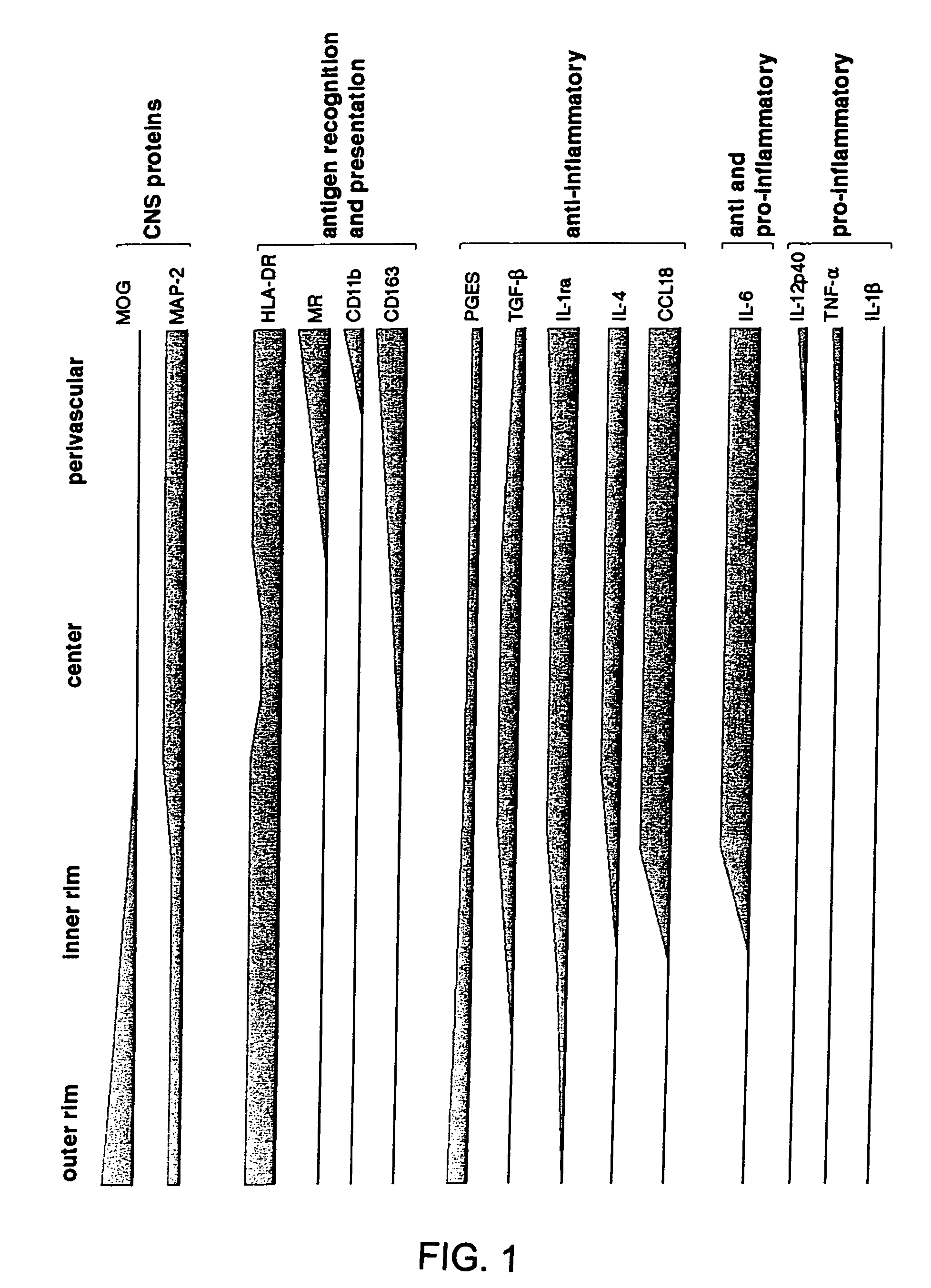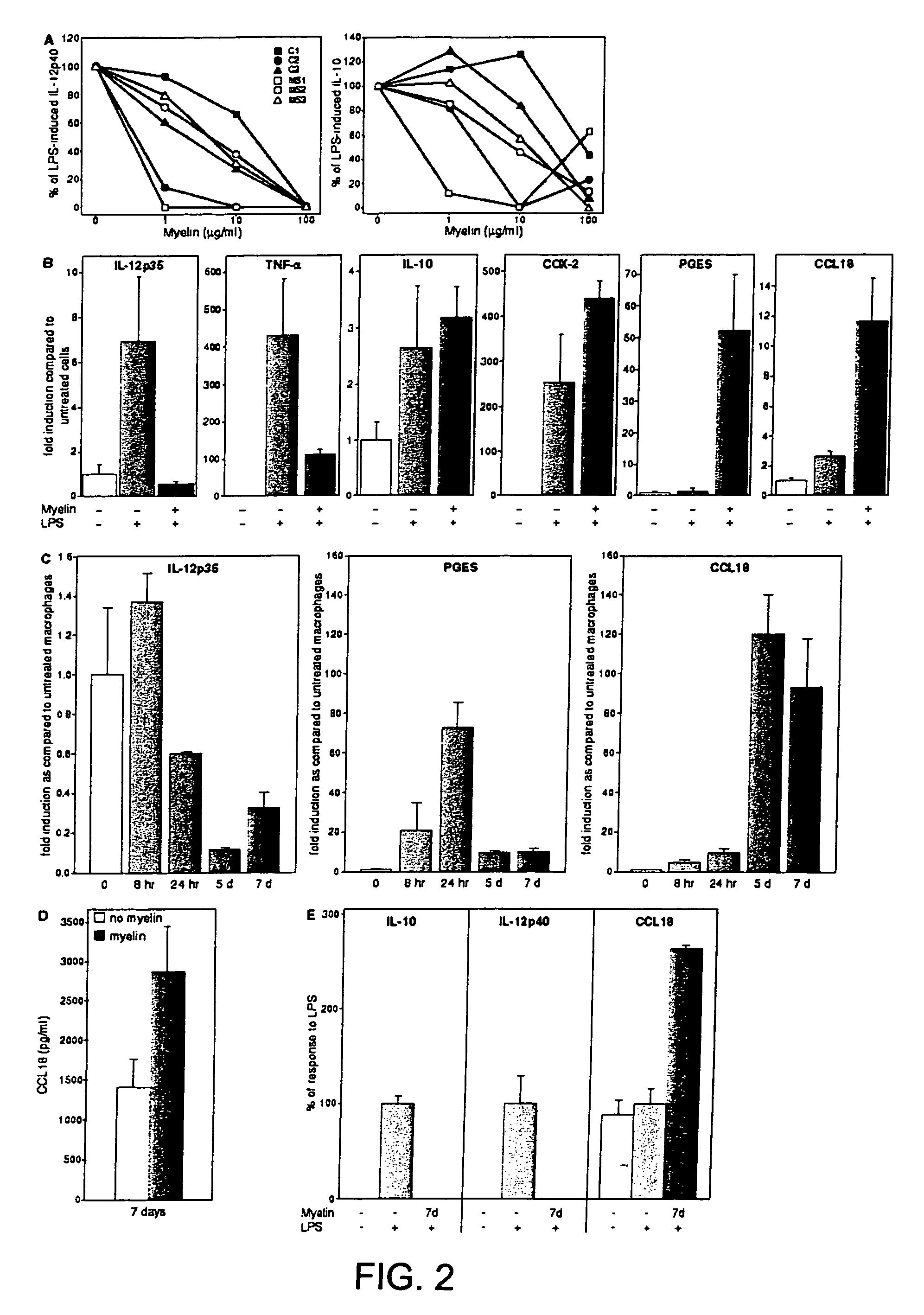Compounds of therapeutic value in the treatment of multiple sclerosis and other diseases wherein foamy cells are involved in the disease etiology
a technology of foamy macrophages and compounds, applied in the field of biotechnology and medicine, can solve the problems of eae models not bridge the considerable gap between eae models and ms, ms is not immune-derived, and it is still unclear if and how foamy macrophages may affect the local inflammatory process
- Summary
- Abstract
- Description
- Claims
- Application Information
AI Technical Summary
Benefits of technology
Problems solved by technology
Method used
Image
Examples
example 1
RESULTS OF EXAMPLE 1
Foamy Macrophages Express Anti-Inflammatory Markers and Demonstrate a Unique Location-Dependent Phenotype
[0041]To determine the immune phenotype of lipid-laden foamy macrophages in MS lesions, we used antibodies against CNS proteins, various surface markers involved in antigen recognition and presentation, and pro- and anti-inflammatory markers characteristic for M1 and M2 macrophages (Goerdt et al., 1999; Gordon, 2003; Kodelja et al., 1998; Mantovani et al., 2002). Foamy macrophages were defined by their characteristic morphology, strong HLA-DR expression and presence of neutral lipids, which are detected by oil red O histochemistry (ORO). To determine whether foamy macrophages display phenotypic and functional specialization dependent on micro-location, we analyzed the phenotype of these cells in different micro-locations. We distinguished between foamy macrophages within the lesion, in perivascular spaces within the lesion and in the outer or inner rim. The di...
example 2
Determining Whether Compounds Modulate Responses by Macrophages and Foam Cells
Experimental Design:
[0054]Human monocyte-derived macrophages were cultured in medium (=macrophages) or in the presence of human brain-derived myelin for 48 hours (=foam cells).
[0055]Macrophages and foam cells were cultured in the presence of 10 microg / ml compounds LAGV (SEQ ID NO: 4), AQGV (SEQ ID NO: 3), LAG, AQG, MTR, MTRV (SEQ ID NO: 2), VLPALPQ (SEQ ID NO: 5), VLPALP (SEQ ID NO: 6), LQGV (SEQ ID NO: 1), LQG (see for example PCT International Publication No. WO 03 / 029292 A2 (published Apr. 10, 2003), PCT International Publication No. WO 01 / 72831 A2 (published Oct. 4, 2001), PCT / EP2004 / 003747, and U.S. Patent Application Publications 20020064501 A1 (published May 30, 2002), 20030119720 A1 (published Jun. 26, 2003), 20030113733 A1 (published Jun. 19, 2003), US 2003 / 0220259 A1 (published Nov. 27th, 2003) and 20030166556 A1 (published Sep. 4, 2003), the contents of all of which are incorporated by this refe...
example 3
Determining Whether Compounds Affect Cytokine Production by Human Macrophages and Foam Cells
Experimental Design:
[0062]Human monocyte-derived macrophages from a healthy blood bank donor were cultured in medium (=macrophages) or in the presence of human brain-derived myelin for 48 hours (=foam cells).
[0063]Macrophages and foam cells were cultured in duplicate in the presence of 10 microg / ml of compounds LAGV (SEQ ID NO: 4), AQGV (SEQ ID NO: 3), LAG, AQG, MTR, MTRV (SEQ ID NO: 2), VLPALPQ (SEQ ID NO: 5), VLPALP (SEQ ID NO: 6), LQGV (SEQ ID NO: 1), LQG for two or eight hours, or cultured in macrophage medium with vehicle.
[0064]Cells were lysed and real time RT-PCR (TaqMan technology) was performed on all samples for GAPDH (housekeeping gene), TNF-alpha. (pro-inflammatory), IL-12p35 (pro-inflammatory), IL-10 (anti-inflammatory), CCL18 (chemokine), COX-2 (prostaglandin pathway).
Results:
Effects of Compounds on mRNA Expression Levels are Depicted in Tables 2, 3 and 4.
[0065]The compounds did...
PUM
 Login to View More
Login to View More Abstract
Description
Claims
Application Information
 Login to View More
Login to View More - R&D
- Intellectual Property
- Life Sciences
- Materials
- Tech Scout
- Unparalleled Data Quality
- Higher Quality Content
- 60% Fewer Hallucinations
Browse by: Latest US Patents, China's latest patents, Technical Efficacy Thesaurus, Application Domain, Technology Topic, Popular Technical Reports.
© 2025 PatSnap. All rights reserved.Legal|Privacy policy|Modern Slavery Act Transparency Statement|Sitemap|About US| Contact US: help@patsnap.com


